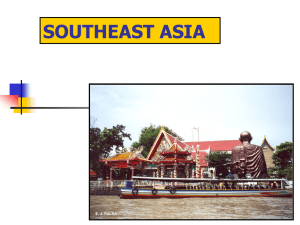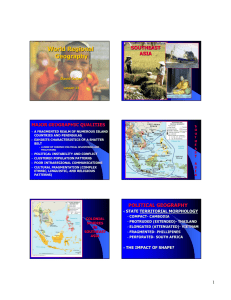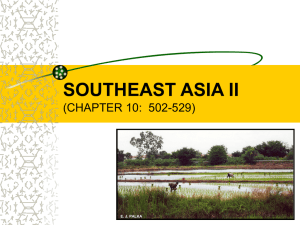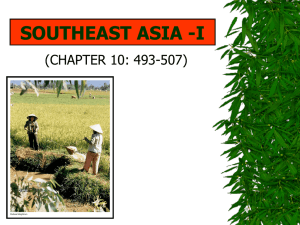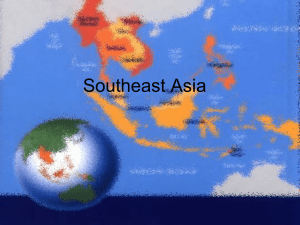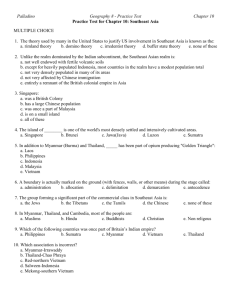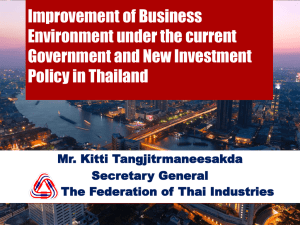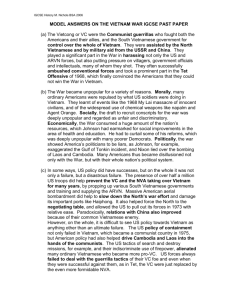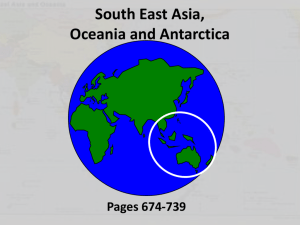SOUTHEAST ASIA -I
advertisement
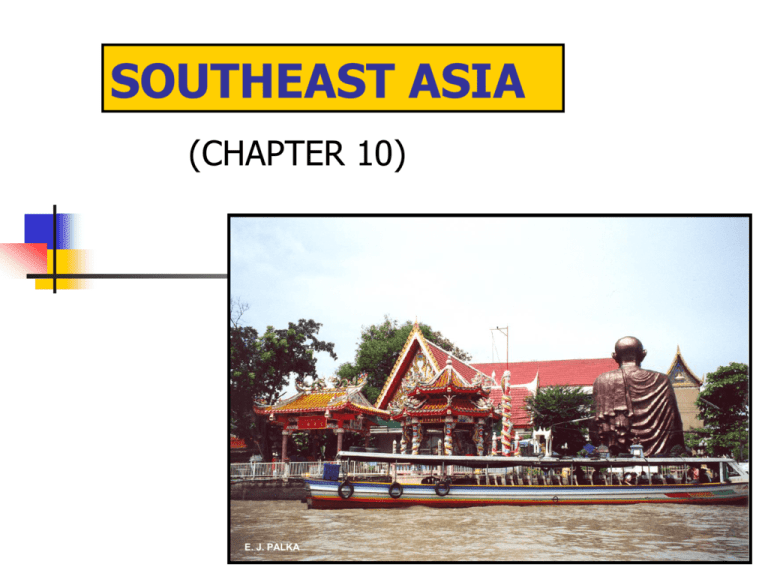
SOUTHEAST ASIA (CHAPTER 10) E. J. PALKA MAJOR GEOGRAPHIC QUALITIES A FRAGMENTED REALM OF NUMEROUS ISLAND COUNTRIES AND PENINSULAS PHYSIOGRAPHY DOMINATED BY HIGH RELIEF, CRUSTAL INSTABILITY, AND TROPICAL CLIMATES POLITICAL INSTABILITY AND CONFLICT CLUSTERED POPULATION PATTERNS CULTURAL FRAGMENTATION (COMPLEX ETHNIC, LINGUISTIC, AND RELIGIOUS PATTERNS) SOUTHEAST ASIA ETHNICITY COLONIAL SPHERES IN SOUTHEAST ASIA POLITICAL GEOGRAPHY STATE TERRITORIAL MORPHOLOGY COMPACT- CAMBODIA PROTRUDED (EXTENDED)- THAILAND ELONGATED (ATTENUATED)- VIETNAM FRAGMENTED- PHILIPPINES PERFORATED- SOUTH AFRICA SHAPES OF STATES COMPACT STATE CAMBODIA A POLITICO-GEOGRAPHIC TERM TO DESCRIBE A STATE THAT POSSESSES A CIRCULAR, OVAL, OR RECTANGULAR TERRITORY IN WHICH THE DISTANCE FROM THE CENTER TO ANY POINT ON THE BOUNDARY EXHIBITS LITTLE VARIATION CAMBODIA, URUGUAY, AND POLAND ARE EXAMPLES. ELONGATED STATE VIETNAM A STATE WHOSE TERRITORY IS DECIDEDLY LONG AND NARROW; ITS LENGTH IS AT LEAST SIX TIMES GREATER THAN ITS AVERAGE WIDTH CHILE, VIETNAM, AND LAOS ARE CLASSIC EXAMPLES. PROTRUDED STATE THAILAND A TYPE OF TERRITORIAL SHAPE THAT EXHIBITS A NARROW, ELONGATED LAND EXTENSION LEADING AWAY FROM THE MAIN BODY OF THE TERRITORY THAILAND AND MYANMAR ARE LEADING EXAMPLES. FRAGMENTED STATE MALAYSIA A STATE WHOSE TERRITORY CONSISTS OF SEVERAL SEPARATED PARTS, NOT A CONTIGUOUS WHOLE THE INDIVIDUAL PARTS MAY BE ISOLATED FROM EACH OTHER BY THE LAND AREA OF OTHER STATES OR BY INTERNATIONAL WATERS. PHILIPPINES AND INDONESIA ARE ALSO EXAMPLES. REGIONS OF THE REALM Mainland Region Vietnam (previously North & South Vietnam) Cambodia (previously French Indo-China) Laos (previously French Indo-China) Thailand (previously Siam) Myanmar (previously Burma) VIETNAM 83.5 million people French delimited Vietnam Not a homogenous colony Divided into three units Tonkin (Hanoi) Cochin China (Saigon) Annam (Hue) VIETNAM Issues/Concerns Population (83.5 million) has doubled since the end of war in 1975 A classic “elongated country” New strategy- retain communist political system but pursue market economics KINGDOM OF CAMBODIA Mekong River Core area in the interior Culturally homogenous (Khmers) Khmer Rouge (communist revolutionaries) Drove people from urban to rural areas Vietnam invaded in 1978 UN sponsored elections 1993 CAMBODIA A classic “compact state” Population of 13.7 million, with strong ethnic and cultural homogeneity- 85% Khmers Phnom Penh (1.3 million) principal city and capital A victim of wars and insurgencies Vietnam spillover 1970 - military deposes of the king 1975 - communist revolutionaries (Khmer Rouge) Invaded by Vietnam in the late 1970s LAOS Independence 1949 Lao People’s Democratic Republic (1975) Communist government Landlocked Rural-based population Little infrastructure and industry LAOS A former French colony (1893-1953) Population of 6.1 million, with 50% ethnic Lao 19% urbanized Undeveloped with no railroads, little industry, and few roads The realm’s poorest country KINGDOM OF THAILAND Leading state of the region Only country in the realm that was not colonized. SelfWesternized. See movie, “Anna and the King” (based on a true story). Economic growth Although some of it stifled by mismanagement Bangkok (Venice of Asia) Problems Surface communications Influx of refugees Drugs THAILAND A classic “protruded state” Population of 64.7 million -- has the slowest growth rate in the realm Per capita GNI is higher than Vietnam, Cambodia, Laos, and Myanmar combined Bangkok- a classic “primate city” of 6.8 million Economic success THAILAND E. J. PALKA E. J. PALKA E. J. PALKA MYANMAR (BURMA) One of world’s poorest countries Independence: 1948 Military government (1962) Core areas: Yangon & Mandalay Ethnic diversity Burman 55% Karen 10% Shan 7% MYANMAR A “protruded state”, with an unserviced extension A former British colony - Burma, which became independent in 1948 Population of 51.5 million, 84 % literate, and culturally diverse Agricultural potential is good; varied soil and environmental conditions; self-sufficient in rice World’s leading producer of opium poppies INSULAR SOUTHEAST ASIA A sub-realm of peninsulas and islands Southeast Asia’s southern and eastern periphery Comprised of 6 States, all of which have colonial histories Malaysia Indonesia Philippines Singapore Brunei East Timor MALAYSIA MALAYSIA Fragmented state - mainland-island type A former British colony Malaysia came into being in 1963, referring to the federal organization and expansion of Malaya (on the Malay peninsula) to include parts of Borneo Population of 26.7 million with strong adherence to Islam Rapidly growing economy, with the 3rd highest GNI in the realm SINGAPORE A city-state Seceded from Malaysia in 1965 Population of 4.3 million (77% are Chinese, 14% Malay, 8% South Asian) Per capita GNI: $24,180 (very high!) INDONESIA INDONESIA A fragmented state of more than 17,000 islands A Dutch colonial creation Population of 225.8 million Major islands (Greater Sunda Islands): Jawa (Java) Sumatera (Sumatra) Kalimantan (part of Borneo) Sulawesi (Celebes) West Papua Jawa is the core with 130 million Largest Muslim population in the world EAST TIMOR Former Portuguese colony Annexed by Indonesia in 1976 Became an independent state in 2002 Population of 800,000 Oil and gas reserves BRUNEI BRUNEI Brunei Darussalam An anomaly in Southeast Asia - an oil exporting Islamic Sultanate A British protected remnant Gained independence in 1984 410,000 people within 2,228 sq mi Oil discovered in 1929, natural gas in 1965 Population is 64% Malay, 11% Chinese PHILIPPINES Republic of the Philippines (1946) Insurgencies PHILIPPINES Archipelago of >7,000 islands, most of which are < 1 square mile Former Spanish colony for 300+ years; U.S. possession (1898-1946) 3 main island groups Luzon and Mindoro (north) Visayan group (central) Mindanao (south) 87.1 million people; 81% catholic Agricultural economy Manila: primate city PHILIPPINES E. J. PALKA E. J. PALKA

